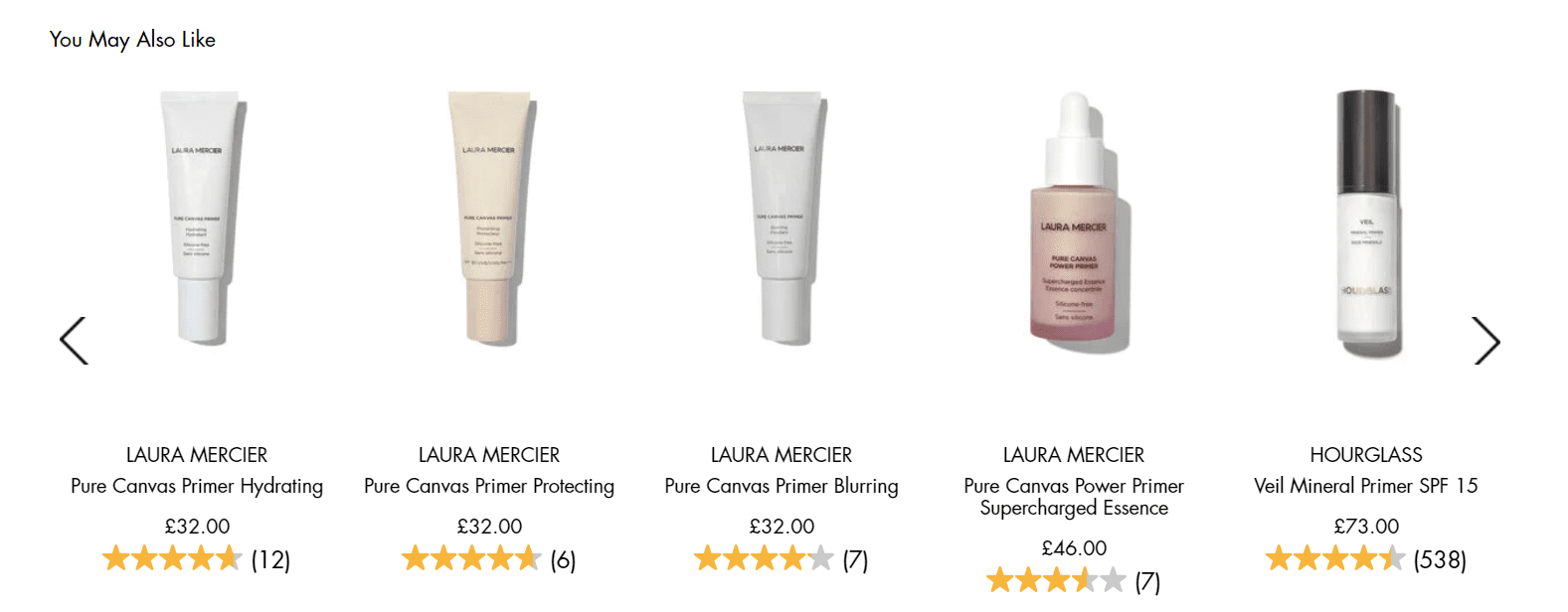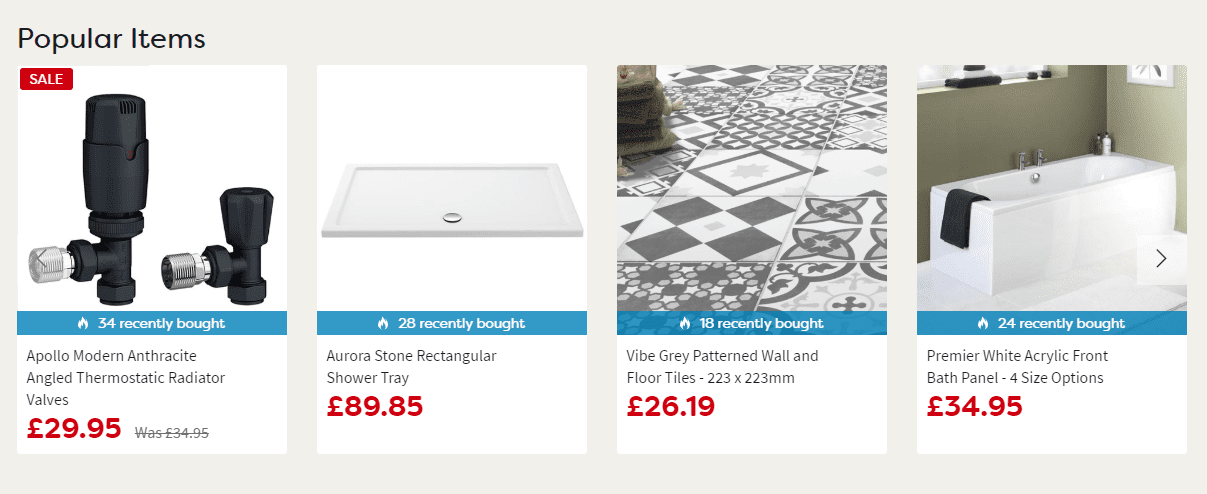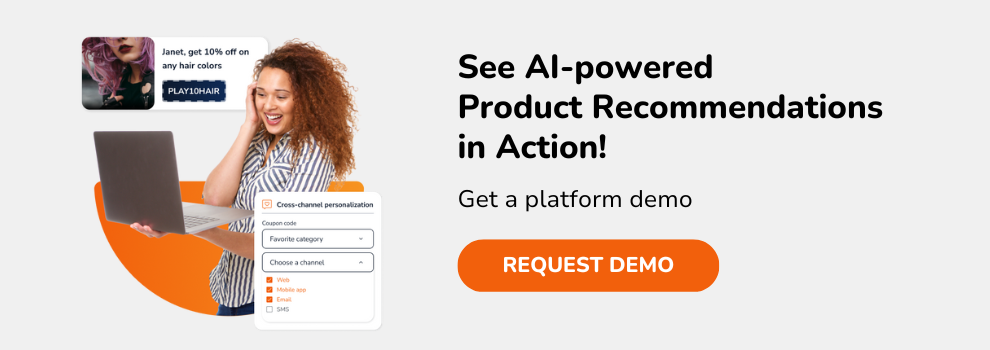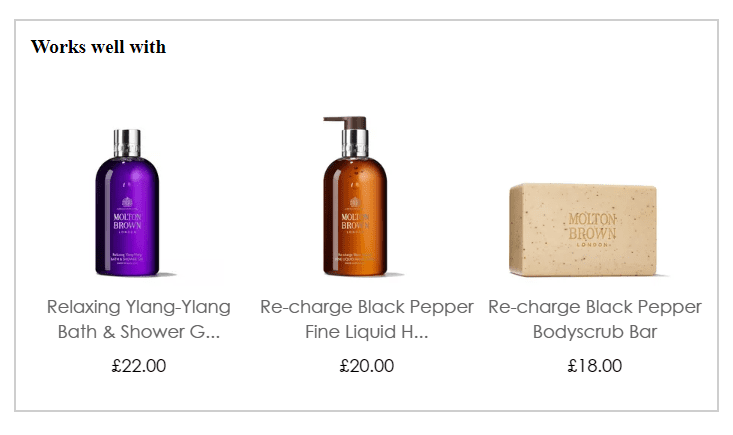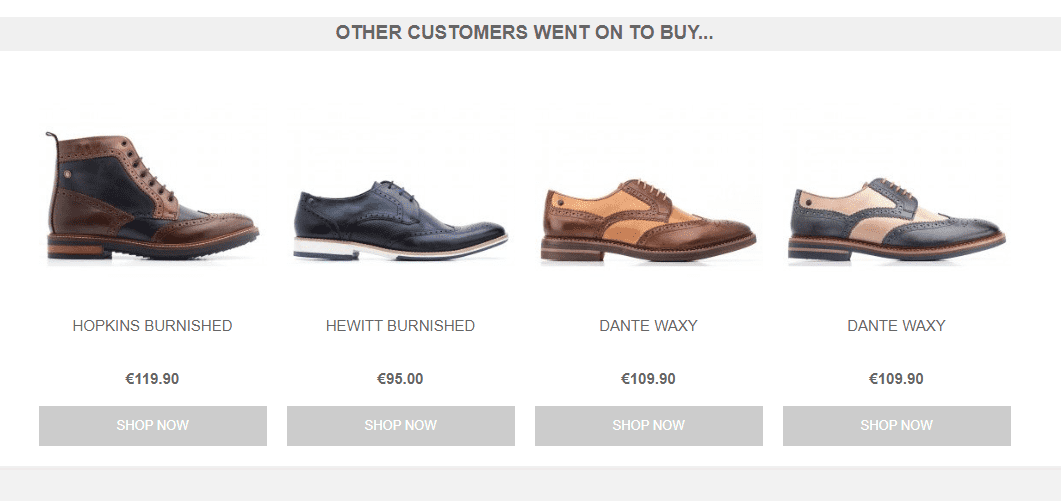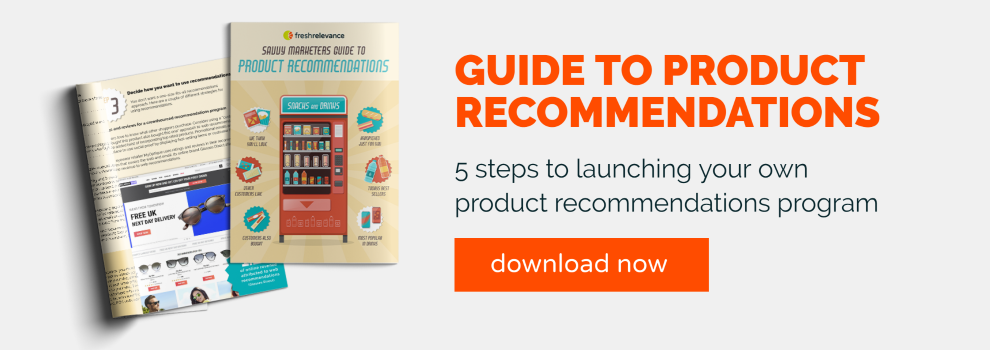The concept of product recommendations is nothing new. Brick-and-mortar stores were employing the tactic long before eCommerce came on the scene and for good reason… Product recommendations work. In fact, product recommendations for your online store can generate sales uplifts of up to 11%.
If you want to get started with your own product recommendations or build on what you already have, take a look at 8 examples of product recommendations we love. We’ll uncover why they work and show you which stage of the customer journey to target for each.
Download now: 5 steps to launching your own product recommendations program [Free eBook]
1. Similar products
This product recommendation tactic suggests products that are similar to the product on the current page, based on the contents of product details such as name, description and tags.
Why does it work?
This tactic allows shoppers to see a range of alternative products similar to the one they’re browsing, allowing them to find the one that best suits their needs.
For retailers who frequently add new or one-off products to their inventory, this tactic works well since you can immediately include recently added items to your recommendation strategy without any manual tagging or customer behavioral data, whilst still recommending relevant products.
Space NK utilizes this type of recommendation on their product pages by suggesting different types of the same product.
Source: spacenk.com
Customer journey
This type of product recommendation is ideal for customers at the research stage of their journey, helping them find the right product for them.
2. “Best-sellers” & “Trending”
This product recommendation tactic suggests products that are trending with other online shoppers. These could be your best-sellers, most browsed or most frequently carted items at the moment.
Why does it work?
This product recommendation tactic makes use of social proof, the concept that people will follow the actions of the masses. This is particularly important for eCommerce, as without the ability to try on, touch and see products in the flesh, customers are more likely to be swayed by other customers’ opinions.
Try adding popularity messaging to increase urgency.
Here’s an example from Victorian Plumbing using trending icons for their best-sellers.
Source: victorianplumbing.co.uk
Include star ratings in product suggestions to ramp up the social proof, like in this example from FFX Tools who also personalized the recommendations to reflect the shopper’s favorite brand.
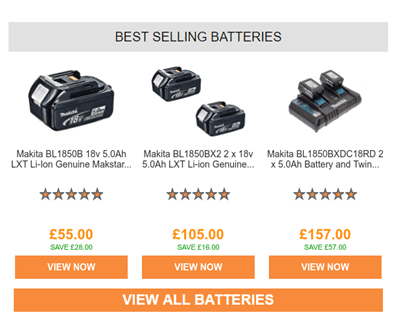
Source: ffx.co.uk
Customer journey
This type of product recommendation works well for customers at the research and purchase stages, who are seeking out extra information about your products, as well as new shoppers whose preferences you don’t yet know.
3. New arrivals
This product recommendation tactic suggests the latest products to be made available – whether that’s across the store, or used as personalized recommendations in the browsed category or from the customer’s favorite category.
Why does it work?
There’s a reason consumers flock to buy the latest iPhone every few years. We have a built-in expectation that something new must be better than what came before. Recommending your newest products also builds excitement around the shopping experience.
This is especially true in sectors driven by fast-moving trends, such as fashion and beauty.
Latest product recommendations work well on the homepage, on the product’s category page and in bulk marketing emails. For more impact, suggestions can be filtered to show new arrivals in the shopper’s preferred category.
In this example, Surfdome gives their new arrivals top billing on their homepage banner.
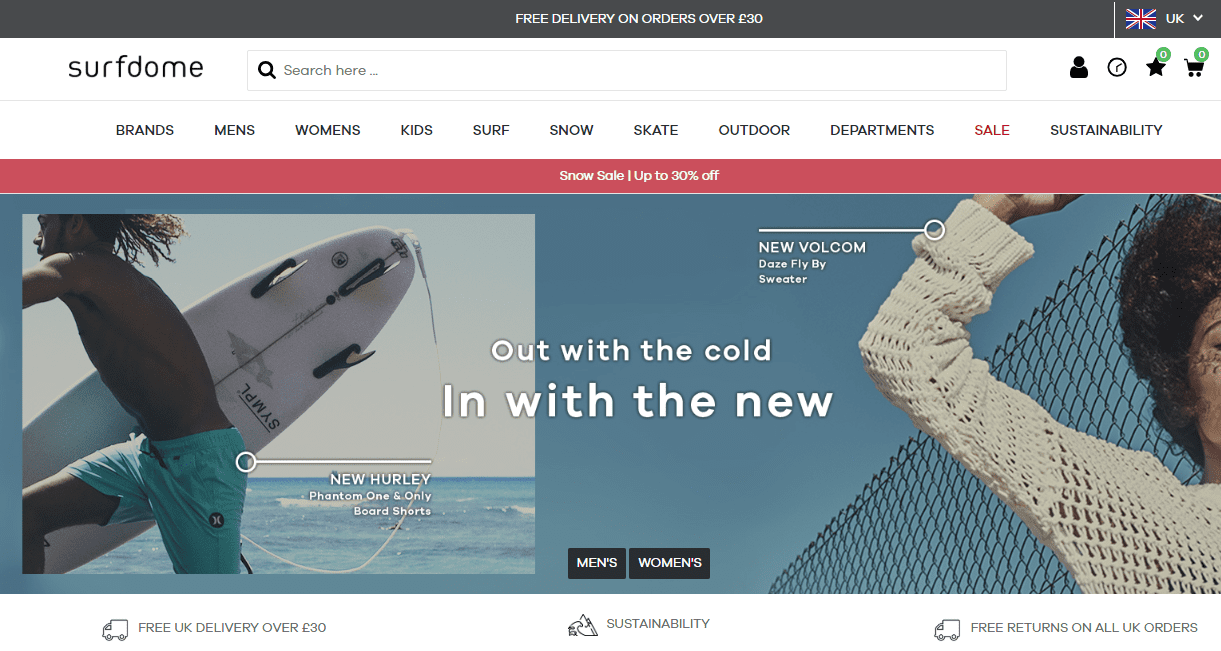
Source: surfdome.com
Customer journey
This type of product recommendation can be used at the research stage of the customer journey.
4. “Frequently browsed” & “Frequently purchased”
These product recommendation tactics suggest products in your online store that this individual shopper has browsed or purchased frequently.
Why does it work?
These types of personalized recommendation are particularly effective because they remind customers about products that they are already interested in but haven’t carted yet or items that are available for repurchase.
This is a great way to engage busy shoppers who might have been distracted before carting their favorite product. It also harnesses the power of familiarity – customers tend to prefer products they have seen multiple times.
You can use this recommendation type on the homepage and in personalized marketing emails to target frequent browsers who haven’t yet made a purchase or to make it easy for loyal customers to replenish their favorite items.
This is a great option for newsletters where it’s appropriate to show a mix of different product types.
Here’s an example of a newsletter from Bear & Bear featuring personalized product recommendations.
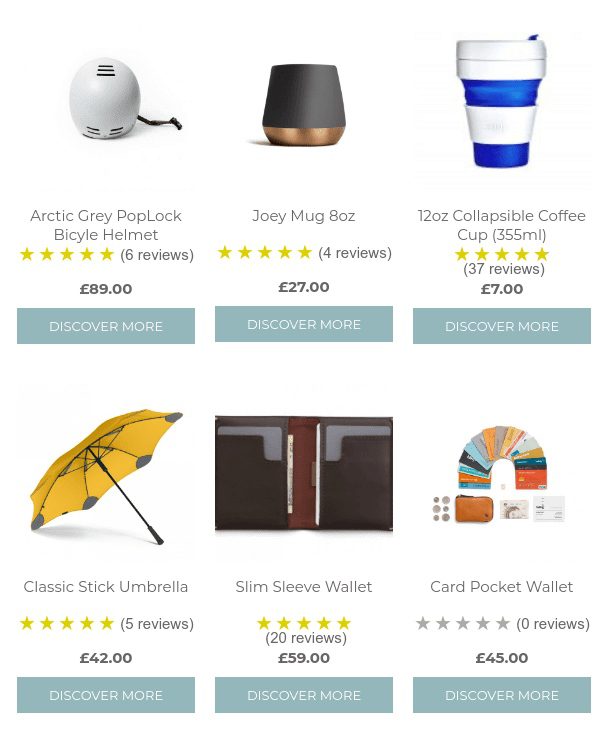
Source: Bear & Bear email
Customer journey
This tactic can be used in the research stage to help the customer make a purchase decision and in the loyalty stage to engage shoppers to restock.
5. “Frequently bought with this” & “Purchased together”
This product recommendation tactic suggests complementary products based on what people who bought this product have ended up buying with it.
Why does it work?
Customers are reminded of accessories and complementary products that they might have forgotten when they filled their cart.
Use this recommendation tactic on your checkout/shopping cart page to increase average order value. Or try adding it to your post-purchase emails to show shoppers the products that they are likely to want and need directly after their original purchase.
Amazon is known to use this kind of recommendation very effectively to increase basket value.
Source: amazon.com
Customer journey
This recommendation tactic is used in the purchase stage of the customer journey, either to increase the order value at the checkout or include in your post-purchase communications to encourage another purchase.
6. Related products
Not to be confused with similar products, this recommendation shows products that you have defined as related to the current product for merchandising purposes.
Why does it work?
This is great for cross-sell and up-sell where the merchandiser needs full control over what products appear together. For instance, it can be used to inspire shoppers with items that complement the one they are browsing.
Molton Brown uses this tactic by displaying items that ‘work well with’ the product the shopper is currently browsing.
Source: moltonbrown.co.uk
Customer journey
This product recommendation type can be used at the purchase stage of the customer journey to increase your average order value.
7. “After viewing this, people buy”
A machine learning algorithm recommends the products in your eCommerce store that shoppers who viewed the product on the current page most often went on to buy.
Why does it work?
Similarly to “People like you buy”, this type of product recommendation leverages the fact that people who share a preference for one product are likely to agree on other products too.
It anticipates the products that are most likely to lead to a conversion and lets you showcase a wider range of your product inventory to shoppers. Customers get to see popular items that they might not have thought about when they made their initial search on the product detail or checkout page.
Here’s an example from a Base London product detail page, showing customers the products most likely to lead to a purchase.
Source: baselondon.com
Customer journey
Again, this recommendation tactic is used in the purchase stage of the customer journey.
8. “People like you buy”
This tactic looks at the shopper’s product purchase history, and compares with other shoppers who’ve viewed those products, using a machine learning algorithm to recommend the most likely eventual purchases.
Why does it work?
By including a header such as “People like you buy”, you appeal to the shopper’s desire to follow the wisdom of the crowd, putting their purchase decision into the capable hands of their shopping predecessors.
Try out this all-purpose recommendation tactic on your homepage, product pages and search pages, for example, and in your marketing emails.
Recommendations can be used to increase engagement with booking abandonment emails, like this customer recommendation example from Cottages.com.
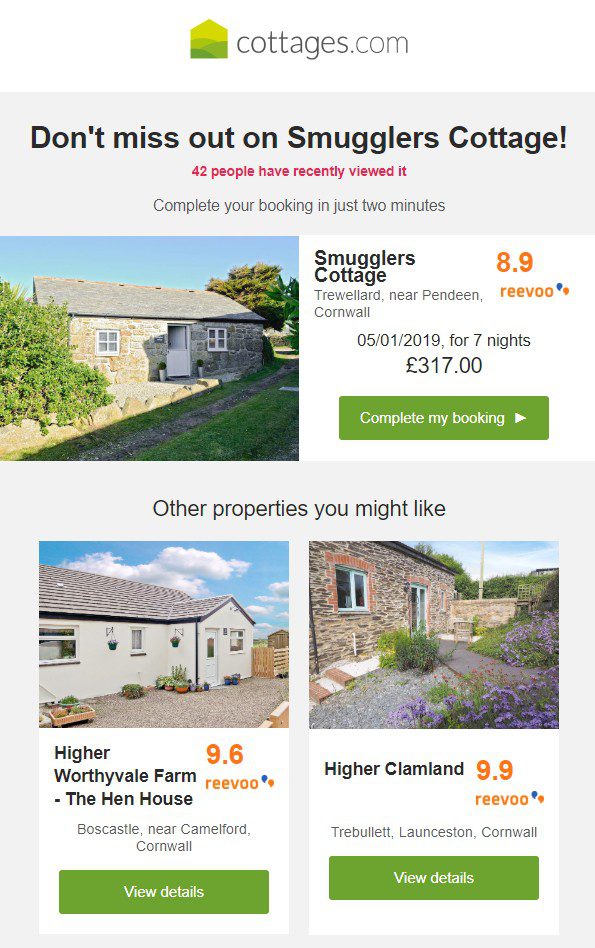
Source: Cottages.com email
Learn more: How Cottages.com achieved a 957% ROI on their browse and cart abandonment programme.
Customer journey
Use this type of product recommendation to target returning customers at the purchase stage of the buying journey. By recommending products using the knowledge you gained from their first purchase, you can encourage repeat purchases and foster customer loyalty. Alternatively, as demonstrated in the example above, you can target customers who were about to make a purchase but abandoned their cart.
Get more out of product recommendations
Advances in machine learning mean it’s easier than ever to serve the most relevant products to customers at the moment when they’re most engaged. AI lets marketers automate eCommerce personalization at scale – so you can devote more resources to producing engaging content and making smart business decisions.
But there are limits to the brilliance of AI, and sometimes a human hand is needed to guide the technology. Imagine these situations:
- You’re a retailer selling multiple brands, and need strict control over which labels appear side-by-side.
- You have an excess stock of one particular product that you need to clear before next season.
- You want to boost the revenue from product recommendations by only showing your highest-margin products.
The most effective product recommendation engines combine the power of machine learning with the ability to filter recommendations based on your priorities. The machine takes on the difficult task of picking out the most engaging products, while marketers keep full control over how content is displayed.
First step to personalization
Experimenting with a mix of personalized and crowdsourced recommendations, social proof and your own business rules, you can achieve a level of personalization that was once only possible in physical stores.
And product recommendations aren’t difficult to implement. The right solution will work with your eCommerce platform, customer data platform and ESP to help you integrate personalized product suggestions across your online channels.
Get our five steps to launching your own product recommendations program in The Savvy Marketer’s Guide to Product Recommendations.
Disclaimer
This blog post is for informational purposes only. Fresh Relevance is not claiming to provide its services to the companies and brand owners referred to in the blog post.



